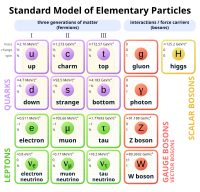
Photo from wikipedia
Majorana fermions, as electronic quasi-particle modes in solid states, have been under the focus of research due to their exotic physical properties. While the evidence of Majorana fermions as zero-dimensional… Click to show full abstract
Majorana fermions, as electronic quasi-particle modes in solid states, have been under the focus of research due to their exotic physical properties. While the evidence of Majorana fermions as zero-dimensional bound states has been well established, the existence of one-dimensional Majorana modes is still under debate. The main reason is that the current theoretical proposals of platforms supporting such states are very challenging experimentally. Here, we propose a method to create two-dimensional topological superconductors with a heterostructure of ferromagnet, topological insulator thin film and superconductor. We show that such a system supports one-dimensional chiral Majorana edge modes in a wide range of parameters which is readily achievable in experiments. We further propose a new transport measurement to detect these modes.Majorana fermions, or Majorana quasiparticles, are highly sought after in condensed matter systems due to their nontrivial nature important both in fundamental research as well as potential applications in quantum computing. Here, the authors propose a heterostructure of ferromagnet, topological insulator film, and superconductor, and demonstrate theoretically that chiral Majorana edge modes could exist in realistic experimentally accessible parameter regimes.
Journal Title: Communications Physics
Year Published: 2019
Link to full text (if available)
Share on Social Media: Sign Up to like & get
recommendations!